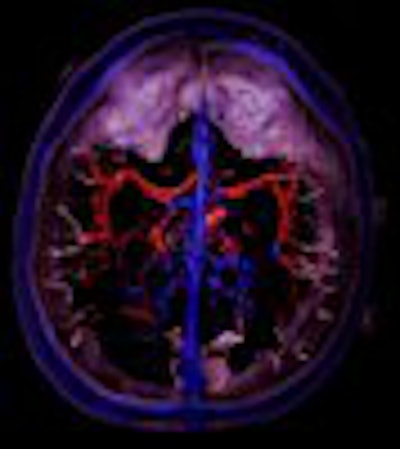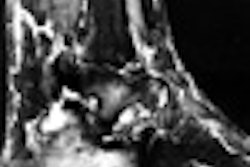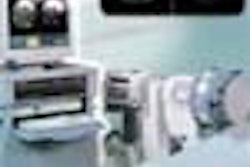
Image-guided surgery could get a boost with the commercial introduction of startup Cbyon's neurosurgical software system at this week's American Association of Neurological Surgeons (AANS) meeting in Canada.
From CT or MRI images of a surgical site, the software creates volumetric 3-D reconstructions of both surface and internal anatomic features. When combined with optical tracking of surgical instruments in real time, the Cbyon Suite correlates the medical images to the actual patient as seen by the surgeon, and continuously displays precisely where the surgeon's tools are in 3-D space relative to the patient's anatomy. The results, according to Cbyon, are accurate overlays that show transparent images of a particular region of interest.
Until now, correlating preoperative 2-D CT or MRI scans with intraoperative x-ray or video images with the patient's anatomy depended on the knowledge and experience of the surgeon, said Ramin Shahidi, Ph.D., who developed the software.
Shahidi is the founder and chief technology advisor of Cbyon. Mitchell Seyedin, Ph.D., founder of medical device developer Orquest, serves as Cbyon's president and CEO. The privately held firm is venture-capital backed, according to Anita Chambers, vice president of marketing.
The technology was developed at the Image Guidance Laboratory at Stanford University by Shahidi, director of the lab and a professor of neurosurgery, surgery, and electrical engineering. The patents were originally held by Stanford. Cbyon ("see beyond") was formed to commercialize the products and is now the exclusive licensee.
The Cbyon Suite workstation and software cost about $120,000. Cbyon also offers a fee-for-service model so that a hospital can pay for it out of the operations budget on a per-use basis. Although Cbyon bundles the hardware and software, in the future it should be possible to operate the suite on a standard personal computer with a special graphics card, Chambers said.
"This provides the surgeon with powerful tools for minimally invasive procedures," Shahidi told AuntMinnie.com. "First is the use of 3-D perspective rendering for intraoperative image-based guidance of surgical instruments. Second, and most importantly, is the correlation of intraoperative video images, like those from endoscopes or microscopes, with 3-D perspective images rendered from preoperative or intraoperative scans."
Cbyon will introduce an ear, nose, and throat (ENT) software suite in May at the Combined Otolaryngology Spring Meeting (COSM) in Palm Desert, CA, and plans to follow with a spine product in the fourth quarter. The company has 510(k) clearance for all three products.
"Even though the company is only two years old, we've been working on this for seven years. That's why we have all the clearances," Chambers said.
Cbyon's preoperative scans are of relatively rigid structures such as the brain or sinuses, Chambers said. "Down the road we're looking at incorporating ultrasound as an acquisition method to do soft tissue and move into cardiac, [gynecology], and general abdominal surgery applications. This would allow us to create our virtual patient on the fly, and have perfect tracking as surgery proceeds."
Chambers acknowledged that image-guided surgery hasn't exactly set the world on fire. She said that's because no image-guided surgery company has delivered a product that is both practical and clinically relevant.
"The Cbyon Suite delivers a new method of visualizing the patient's anatomy that brings clinical relevance and practicality to image-guided surgery," she said. "We feel that these advances will enable certain procedures that are currently performed in open surgery to be performed in a minimally invasive fashion."
Chambers said other image-guided systems (e.g., Medtronic's StealthStation, BrainLAB's VectorVision, and products by VTI and Tyco/Radionics) are also used to track surgical instruments, but with limitations.
"They do this by displaying three orthogonal views of preoperative CT or MR scans," she said. "Then they display crosshairs of each of the three scans to indicate the surgical instrument's location. The downside of the technique is that the surgeon has to look at different images to guide the instrument."
"We do it with the concept of a virtual patient, so when you look at an image from the Cbyon Suite, you see the instrument moving in a virtual model and you can look at it from any perspective. You can see objects beyond the surface view."
The company has received financing from venture capital firms Bedrock Capital, Tredegar Investments, Charter Venture Capital, Alloy Ventures, Asset Management Co., and Mitsui Private Equity. Cbyon is looking for another round of funding in the near future, and plans to go public in about 18 months, Chambers said.
The company has no stated plans to partner with an OEM, and is concentrating on its U.S. launch this week. "We're hiring a direct sales force with endoscopic experience, and are investigating distribution channels internationally," Chambers said.
By Robert BruceAuntMinnie.com contributing writer
April 23, 2001
Click here to post your comments about this story. Please include the headline of the article in your message.
Copyright © 2001 AuntMinnie.com



















